Elizabeth City County
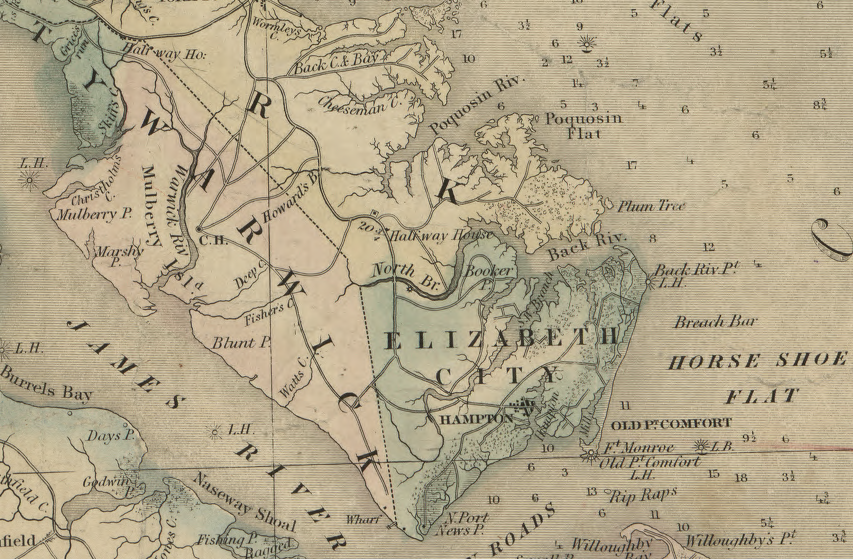
Elizabeth City County has been incorporated into the City of Hampton, and Warwick County has been incorporated into the City of Newport News
Source: Library of Congress, A map of the state of Virginia, constructed in conformity to law from the late surveys authorized by the legislature and other original and authentic documents (1859)
The English discovered the original name for the area that became Elizabeth City County when they sailed into the Chesapeake Bay in 1607. The Susan Constant, Godspeed, and Discovery stopped at a place the English named Point Comfort. Nearby they found a Native American town named Kecoughtan, which the English also spelled Kikotan and Kikowtan. The natives there were recent immigrants themselves, occupying that part of the peninsula only after Powhatan had defeated and expelled the previous residents.
Sir Thomas Gates coveted the corn fields of the Native Americans after the "starving time" of the 1609-10 winter. He also worried about potential attack by the Spaniards or Dutch. The English seized the town of Kecoughtan while the men were hunting, and started a new settlement with a new set of immigrants.
In 1619, two representative from Kecoughtan attended the first-ever meeting of the General Assembly. They requested that the Virginia Company to replace the "savage" name used by the Native Americans for the site, and the company chose to honor James I's daughter.1
Princess Elizabeth was born in 1596 when her father was King James VI of Scotland. He named her in honor of Elizabeth I, then the Queen of England. Elizabeth's marriage to German Protestant, Frederick V, Elector of the Palatinate, was arranged by her father as part of the never-ending jockeying for power in Europe. "Electors" were rulers who were entitled to vote for the head of the Holy Roman Empire.
In 1619, Frederick became a king when he accepted the crown of Bohemia, and Elizabeth became Queen of Bohemia. The Kecoughtan representatives to the General Assembly in 1619 chose to honor the daughter of King James I, the new Queen of Bohemia, when they abandoned the "savage" Native American name.
Frederick V was invited to assume the throne because he was a Protestant. The Bohemians were trying to block a Catholic from the powerful Habsburg family from becoming their king; Protestant nobles feared the Hapsburgs would force them to transfer land and wealth to the Catholic church. Elizabeth became a queen as a result of the Bohemian Revolt, but a Catholic army quickly defeated the army of Frederick V. The fighting in Bohemia initiated the Thirty Years War, a series of conflicts which disrupted Europe until the 1648 Peace of Westphalia.
Elizabeth and Frederick were forced to flee Bohemia, and they settled in the Dutch Republic. The daughter of James I was a Stuart princess for life but a queen for just one winter. However, her grandson became King George I of England in 1714. He had less of a claim to the throne through genealogy than the son of King James II, but religion was a key factor in George's selection. Like his grandmother and grandfather, George I was a Protestant while the alternatives were Catholics.
When the General Assembly created Elizabeth City County in 1634, Elizabeth was living in the Dutch Republic as a widow. Her husband had died two years earlier from the plague. She played no role in politics and had no special influence or reputation in England, but she was the sister of King Charles I. Naming places after members of the royal family was a politically wise move, since Virginia was a royal colony.2
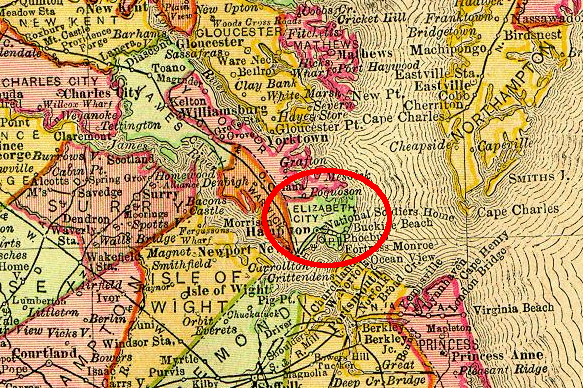
Elizabeth City County existed between 1634-1952 on the tip of the Peninsula at Hampton Roads
Source: Ray Sterner, Rand-McNally's 1895 Atlas
Elizabeth City County was one of the eight the first counties - originally called shires - created by the General Assembly in 1634. Initially it included land on both sides of the James River, from the tip of the Peninsula to the Atlantic Ocean. That lasted only two years. Creation of New Norfolk County in 1636 removed all the land south of the James River from Elizabeth City County.
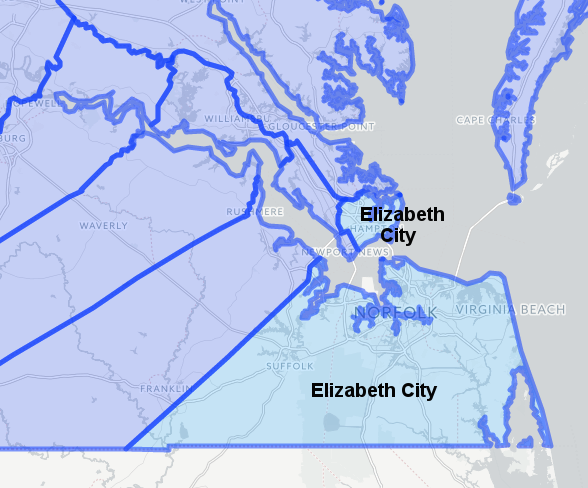
when first created in 1634, Elizabeth City County included land on both sides of the James River
Source: Newberry Library, Atlas of Historical County Boundaries
The county's land area and population was reduced again in 1908 when Hampton obtained a charter as an independent city. Taxes on property that once provided revenue to the county were diverted to the city, though the county was no longer required to fund schools, police, and other services to Hampton residents. Annexations by the City of Newport News reduced the county further in 1921 and 1927.3
During the Civil War, Union forces maintained control of Fort Monroe. That led to enslaved people fleeing through Elizabeth City County to seek freedom at the fort.
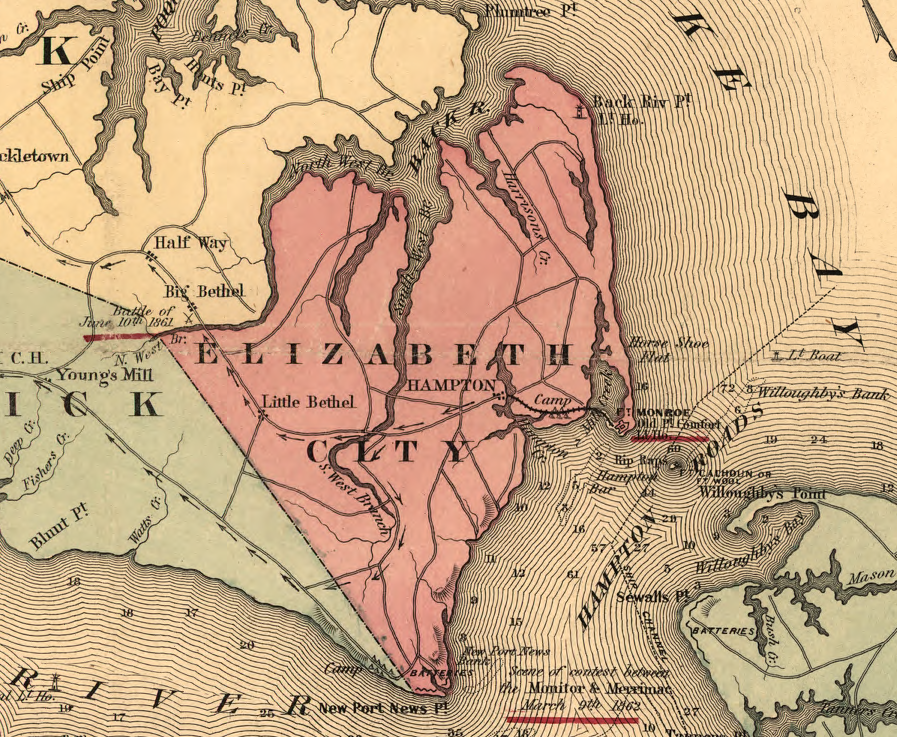
during the Civil War, three enslaved people came to Fort Monroe in Elizabeth County and were declared to be "contraband" of war
Source: Library of Congress, Hare's map of the vicinity of Richmond, and Peninsular campaign in Virginia (by J. Knowles Hare, 1862)
Colis P. Huntington extended the Chesapeake and Ohio Railroad east of Richmond in 1882, building track down the Peninsula to a new port just east of the Elizabeth City County boundary. He also founded a shipyard, the Chesapeake Dry Dock and Construction Company. In 1896 a portion of Warwick County was incorporated as the independent City of Newport News. That city annexed slices of Elizabeth City County in 1921 and again in 1927.
The 1927 annexation was initiated by residents of the Town of Kecoughtan in Elizabeth City County. A group of citizens seeking to become part of the City of Newport News petitioned the Circuit Court in 1923. The court took two years before ruling on the controversial proposal. The judges directed that the annexation, affecting about 1,500 people, go into effect at the start of 1927.4
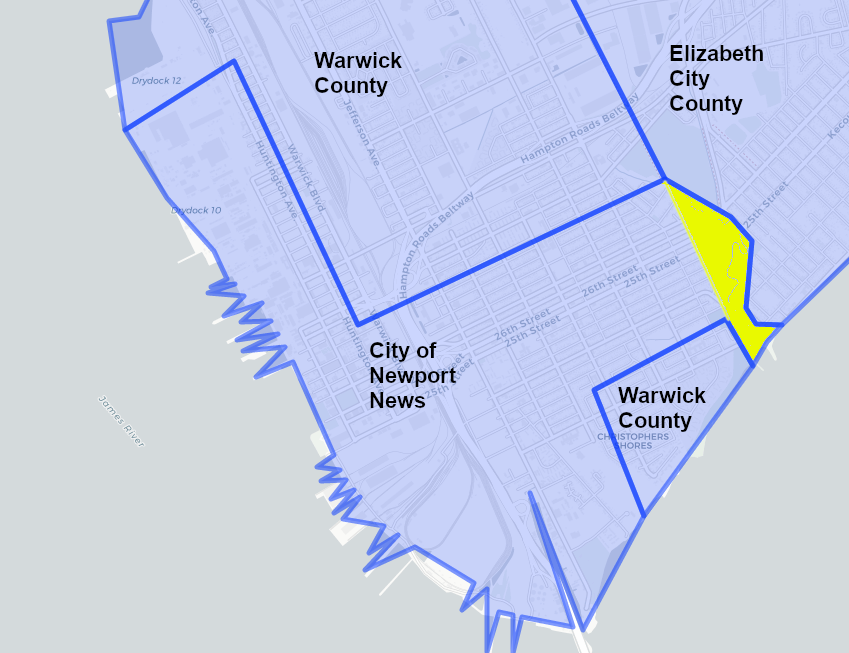
the independent city of Newport News annexed a portion of Elizabeth City County (yellow) in 1921
Source: Newberry Library, Atlas of Historical County Boundaries
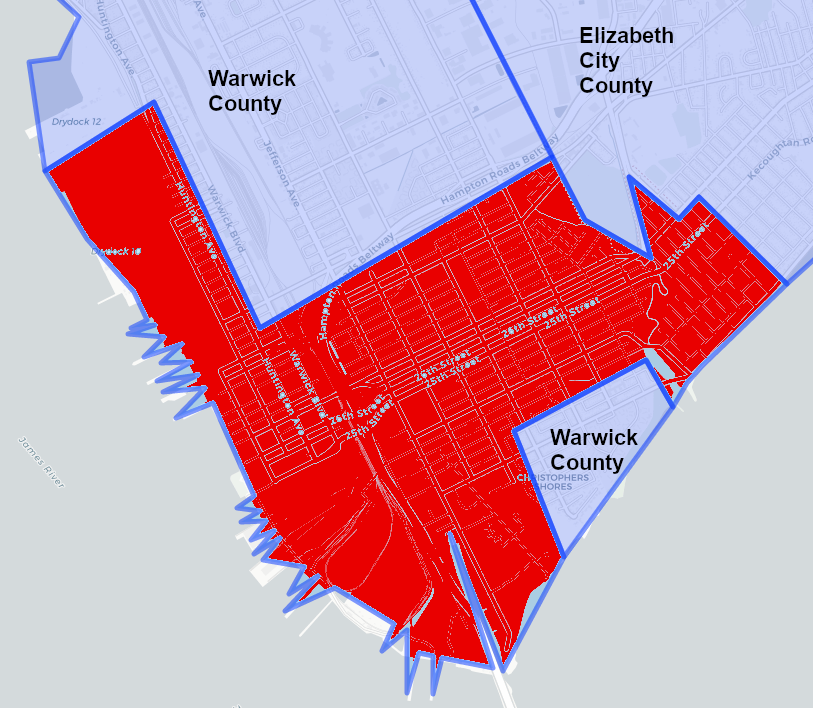
the independent city of Newport News (red) annexed the Town of Kecoughtan from Elizabeth City County in 1927
Source: Newberry Library, Atlas of Historical County Boundaries
The population in the Hampton Roads area swelled after World War II. New housing developments sprawled into rural areas, but in the days of segregation and home mortgage "redlining" black residents stayed concentrated in Newport News. As the author of a Masters Thesis has noted:5
While the white population could leave for the suburbs, the black populations remained stuck in the city, changing a once integrated landscape (if not an integrated society) to one of a segregated landscape (if not a segregated society.)
In 1946 the mayor of Newport News suggested that the city would expand its boundaries:6
- I am of the opinion that this community will ultimately become a great city. In the not too distant future, it would not be unreasonable to expect a successful consolidation of portions of Warwick and Elizabeth City Counties with Newport News, thereby affecting many advantages and increasing the land area and population of the city.
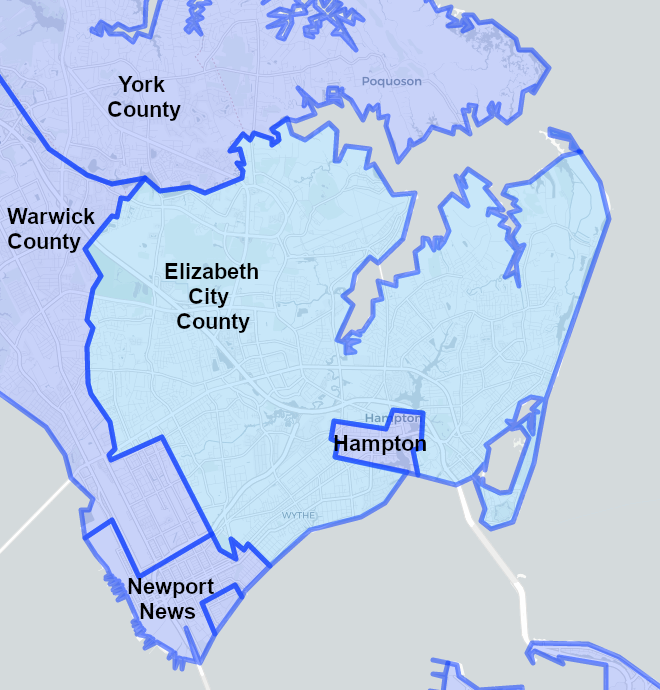
Elizabeth City County surrounded the City of Hampton between 1927-1952
Source: Newberry Library, Atlas of Historical County Boundaries
In 1950, political leaders on the Peninsula proposed consolidating the counties of Warwick and Elizabeth City, the cities of Newport News and Hampton, and the Town of Phoebus into the "City of Hampton Roads." Voters in four jurisdictions endorsed the proposal, but it failed when Hampton voted against it.7
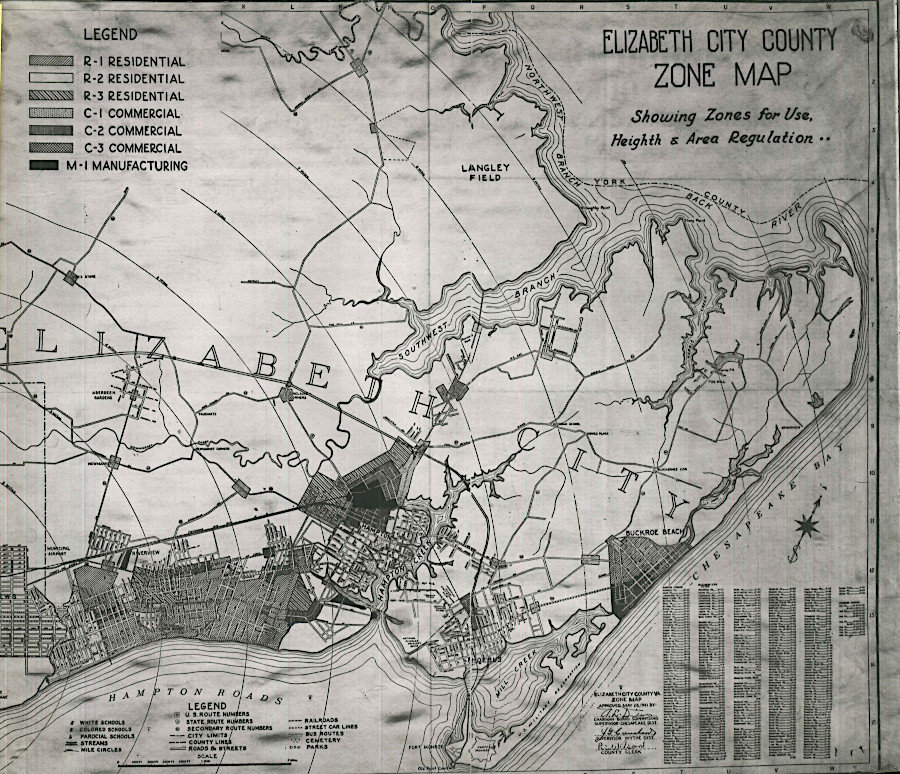
Elizabeth City County implemented zoning before merging into the City of Hampton in 1952
Source: National Archives, History of Langley Air Field, Inception to March 1, 1935 (p.18)
As counties, Warwick County andd Elizabeth City County were left vulnerable to annexation efforts by the City of Newport News. Warwick changed its status and became an independent city in 1952. That protected Warwick from Newport News, since state law did not permit a hostile annexation of land from a city.
Elizabeth City County took the same route; the county and the Town of Phoebus. Elizabeth City County disappeared in 1952 when the county and town became the city of Hampton. As a result, Elizabeth City County became the first of the orginial eight "shires" to disappear completely.
That merger, the first in Hampton Roads, was followed by efforts to combine the cities of Newport News and Warwick with the newly-enlarged city of Hampton, a repeat of the 1950 consolidation proposal. Voters in Hampton rejected the proposal to create "Port City" in 1956. In response, Warwick and Newport News abandoned efforts to expand their boundaries eastward to Fort Monroe, and the two cities united in 1958.8
Since then, political boundaries of what was once Elizabeth City County have not been altered. The independent cities, counties and towns streamline water, wastewater, jail, transportation, and other government functions through regional agencies and maintain separate government jurisdictions.
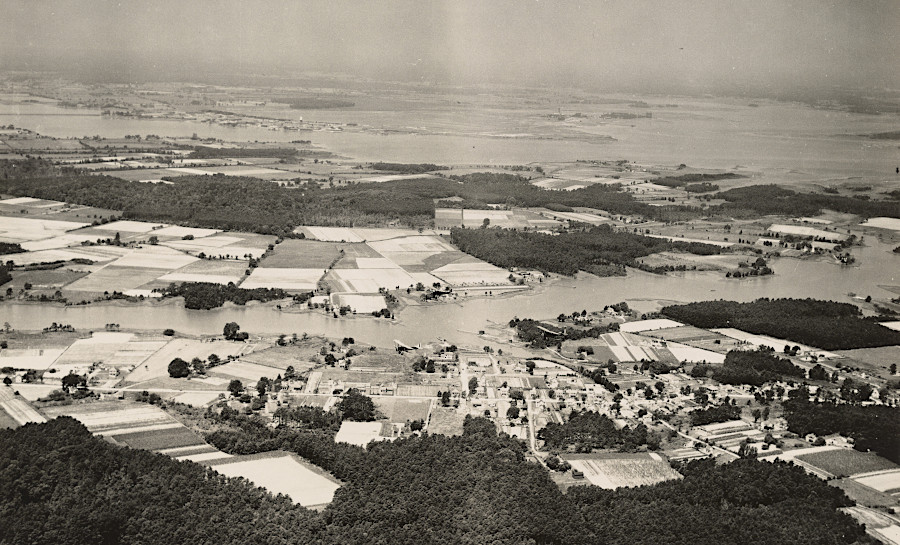
biplanes from Langley Field in formation over Fox Hill, north of Phoebus, before World War II
Source: National Archives, Virginia - Fox Hill
Links
References
1. "Uncovering Traces of Historic Kecoughtan," Center for Archaeological Research, College of William and Mary, http://www.wm.edu/sites/wmcar/research/pentran/index.php (last checked January 9, 2016)
2. "Who was the 'Winter Queen'?," Royal Museums Greenwich, https://www.rmg.co.uk/stories/topics/elizabeth-stuart-bohemia-winter-queen (last checked August 1, 2021)
3. "Virginia: Individual County and Independent City Chronologies," Virginia Atlas of Historical County Boundaries, The Newberry Library, 2003, https://digital.newberry.org/ahcb/documents/VA_Individual_County_Chronologies.htm#Individual_County_Chronologies (last checked August 1, 2021)
4. "Cities of Virginia," The Hornbook of Virginia History, Encyclopedia Virginia, Virginia Humanities, December 7, 2020, https://encyclopediavirginia.org/entries/cities-of-virginia/; "Millennial Moment: Town Of Kecoughtan," Daily Press, October 21, 1999, http://articles.dailypress.com/1999-10-21/news/9910210029_1_town-hall-town-attorney-town-s-treasury (last checked August 1, 2021)
5. David Le Moal, "Consolidation: Race, politics, and suburbanization in the Newport News-Warwick merger," Masters Thesis, James Madison University, 2018, p.7, https://commons.lib.jmu.edu/master201019/629/ (last checked August 1, 2021)
6. "History of Consolidation," City of Newport News, https://www.nnva.gov/282/History-of-Consolidation (last checked August 1, 2021)
7. "History of Consolidation," City of Newport News, https://www.nnva.gov/282/History-of-Consolidation (last checked August 1, 2021)
8. David Le Moal, "Consolidation: Race, politics, and suburbanization in the Newport News-Warwick merger," Masters Thesis, James Madison University, 2018, pp.4-5, https://commons.lib.jmu.edu/master201019/629/; "Cities' Merger Considered, Rejected," Daily Press, January 30, 1992, https://www.dailypress.com/news/dp-xpm-19920130-1992-01-30-9201300064-story.html (last checked August 1, 2021)

in 1651, John Farrer located a town called Elizabeth City at the site of modern Poquoson
Source: John Carter Brown Library, A mapp of Virginia discouered to ye Falls, and in it's Latt: From 35 deg: & 1/2 neer Florida to 41 deg: bounds of new England (by John Farrer in 1651)
Virginia Counties
Virginia Places









